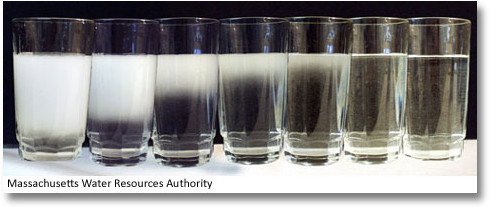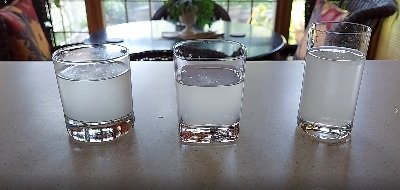Home Water Treatment
Why is My Water Cloudy?
We're an affiliate
We hope you love the products we recommend! Just so you know, we may collect a share of sales or other compensation from the links on this page. Thank you if you use our links, we really appreciate it!
Did you just fill a glass with water and notice the water was cloudy?
It can cause you to be afraid to drink it. You might worry it could make you sick.
You’re right to be concerned, drinking contaminated water can make you sick.
In this blog post we will explore the reasons your water can become cloudy and what you can do about it.
Why is my water cloudy?
There are two reasons for your water to appear cloudy. The first cause of cloudiness is dissolved gasses that have come out of solution.
The second reason the water is cloudy is tiny particles or contaminants. When particles in the water cause cloudiness, the technical term is turbidity. Water supplies take turbidity measurements multiple times a day.
Tiny Air Bubbles
Tiny gas bubbles that are temporarily suspended in the water can cause the cloudiness.
How do I know if it is air?
Here is a simple way to tell if air bubbles cause the cloudiness. Take a clear glass and fill it with water from the tap. Watch the water in the glass and notice whether the water clears from the bottom up or the top down. If it clears from the bottom up, gas bubbles cause the cloudy condition. The bubbles simply float to the surface and are released into the air.

Different Stages of Water Clearing from the Bottom
Water Temperature and Pressure Can Be a Factor
An interesting thing about water is, the colder it is, the more gas it can dissolve. As the water gets warmer, it releases the dissolved gasses. That’s why you see air bubbles on the inside of a glass of water that has been sitting on the counter for a while. The reason is the water temperature rose, and the air separated from the water to form bubbles, some of which were attached to the side of the glass.
In the winter, the water entering your house is usually colder than normal. Also, the water is under pressure as it is pumped to your home. Water under pressure can hold even more air. As the water warms up in your plumbing, any dissolved gases will be released when the water comes out of your faucet you might see a cloudy appearance. This is like a carbonated soft drink when you first open it and you see the tiny bubbles appearing.
Other Ways Air Can Get Into Water
Air can sometimes enter the water system after a water main break has been repaired. It happens as the repair crew fills the empty line with water. They have to fill the line slowly and that process introduces a lot of air into the water. The employees that repaired the pipe will do their best to flush the air out of the line. It is difficult to get all the air out of the line after the repair.
Usually, your faucet will often have a small screen at the opening. When the water passes through the screen, air will be added to the water. The screen on the faucet is an aerator.
What to do When Air Didn’t Cause the Cloudiness?
When the water doesn’t clear from the bottom up, or doesn’t clear up at all, air did not cause the problem. It could still be something simple, like lime build up in the water mains leading to your home. While it may be simple, it is not normal. In this case, do not drink the water. And call your water supplier.
While lime or calcium deposits may seem harmless, there is no way to know for sure without performing a series of tests on the water to determine what is causing the cloudy condition. But your water system operator will give you guidance.
Can You Tell What is in the Water by Looking At It?
Below is a picture of three glasses. One has milk in it, one has flour and one has white latex paint. Just by looking at the glasses, can you tell what is in each glass?

I have created a video that will show you the process in reverse order. You can see how similar the contaminants appear, but you can’t determine what is in each glass.
The thing is, unless the contaminant in the water is, in fact, harmless, you shouldn’t drink it.
What You Can Do To Protect Yourself
The easiest way to protect against suspended particles in your water is to install a whole house filter. The type of filter for this task is inexpensive. It installs in the water supply line and filters sediment for every faucet in the home.
The cost for a whole house filter starts at about $35.
If you have cloudy water after installing one of these filters, don’t drink the water. Call your water supplier.
Conclusion:
By now, you know the answer to the question: “Why is my water cloudy?” And you also know how to tell if it is just air in the water that’s causing the cloudiness. In addition, you know not to drink it if it is not air in the water. Finally, you know you can protect yourself in advance by using a whole house filter.
